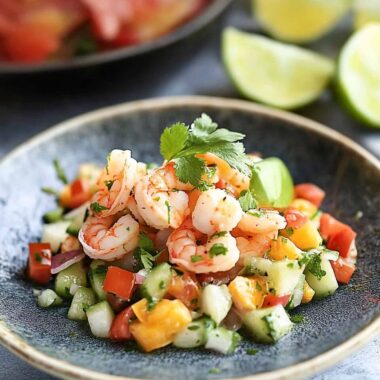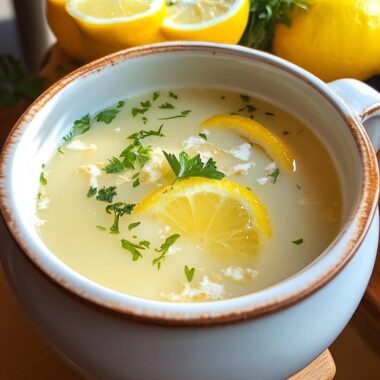The beauty of this pasta lies in its simplicity: just eggs, cheese, pasta, and cured pork yet when prepared with care, the result is a dish that’s rich, savory, and incredibly satisfying. Inspired by Stanley Tucci’s travels through Italy, this carbonara recipe stays true to the traditional Roman method, with no cream added just pure, velvety deliciousness from the egg and cheese emulsion. If you’re a fan of authentic Italian cuisine or simply looking for a fast, crowd-pleasing meal, this carbonara will hit all the right notes. It’s ideal for a quick weeknight dinner or when you want to impress guests without too much fuss. Plus, the ingredients are pantry staples, making it a perfect go-to recipe anytime you crave something indulgent but easy to whip up.
Full Recipe:
Ingredients:
-
12 oz spaghetti
-
4 oz guanciale (or pancetta if unavailable), diced
-
2 large eggs
-
1 large egg yolk
-
1 cup grated Pecorino Romano cheese
-
Freshly ground black pepper, to taste
-
Salt, for pasta water
Directions:
-
Bring a large pot of salted water to a boil. Cook the spaghetti until al dente, according to package instructions.
-
While the pasta cooks, heat a skillet over medium heat and add the diced guanciale. Cook until golden and crispy, about 5–7 minutes. Remove from heat.
-
In a bowl, whisk together the eggs, egg yolk, Pecorino Romano cheese, and a generous amount of black pepper until well combined.
-
Once pasta is cooked, reserve about 1 cup of pasta water and drain the rest.
-
Add the hot pasta directly into the skillet with guanciale (off heat), stirring to combine and allow to slightly cool for 30 seconds.
-
Pour the egg and cheese mixture into the pasta, stirring vigorously to create a creamy sauce without scrambling the eggs.
-
If the sauce is too thick, gradually add a little reserved pasta water to reach your desired consistency.
-
Serve immediately, topped with additional Pecorino Romano and black pepper.
Prep Time: 10 minutes | Cooking Time: 15 minutes | Total Time: 25 minutes
Kcal: 520 kcal | Servings: 4 servings
The Timeless Elegance of Stanley Tucci’s Pasta Carbonara
Stanley Tucci, the acclaimed actor and passionate food enthusiast, has taken us on unforgettable gastronomic adventures through Italy, where food isn’t just sustenance it’s a way of life. One of the standout moments from his popular series Searching for Italy was the exploration of Rome’s iconic dish: Pasta alla Carbonara. This simple yet sophisticated dish exemplifies the heart of Roman cooking humble ingredients elevated through technique and tradition.
Tucci’s love for authentic, regional Italian cuisine has reignited global appreciation for traditional recipes, and his Carbonara is no exception. Unlike the creamy, bacon-laden versions found in many American kitchens, this dish pays homage to its Roman roots with guanciale, eggs, Pecorino Romano, and spaghetti or rigatoni. The result is a rich, silky sauce that clings to perfectly cooked pasta, delivering deep umami flavor and a luxurious mouthfeel.
The Origins of Carbonara: Myths and Reality
Pasta Carbonara is one of those dishes that feels timeless so much so that its exact origin is a topic of passionate debate. Some say it was born during World War II, when American soldiers stationed in Italy combined powdered eggs and bacon with pasta. Others argue that Carbonara predates the war and evolved from a hearty shepherd’s meal in the Apennine mountains.
The name Carbonara itself is thought to derive from carbonari, meaning charcoal workers, implying that the dish was a popular, hearty meal for those working long, grueling hours outdoors. The black pepper in the recipe, some speculate, resembles flecks of coal adding a poetic layer to the dish’s mythology.
While its true origin may remain a mystery, what’s undeniable is the dish’s revered status in Roman cuisine and how Stanley Tucci’s version captures its spirit with reverence and simplicity.
What Makes Tucci’s Carbonara So Special?
Stanley Tucci’s approach to Carbonara is notable for how intentionally minimalist it is. There are no shortcuts, no unnecessary ingredients just a disciplined focus on technique and quality. Here are some elements that make it truly exceptional:
1. Authentic Ingredients
Tucci insists on guanciale, the cured pork cheek that provides an unmatchable depth of flavor. Unlike pancetta or bacon, guanciale melts into the pasta, releasing a savory fat that becomes the foundation of the sauce.
Instead of Parmesan, Tucci honors tradition by using Pecorino Romano—a sharp, salty sheep’s milk cheese that cuts through the richness of the eggs and pork. And there’s absolutely no cream involved, debunking one of the most common Carbonara myths.
2. Mastering the Emulsion
Perhaps the most delicate aspect of Tucci’s Carbonara lies in its technique. Once the pasta is combined with the rendered guanciale, the residual heat is used to gently cook the eggs and cheese into a glossy, velvety sauce.
This requires skill and confidence, as the eggs must not scramble. The key is to stir vigorously off heat, adding pasta water incrementally to loosen and emulsify. When done right, the result is a creamy texture without a drop of dairy cream.
3. Respecting Simplicity
What Tucci shows us, time and again, is that Italian cooking is less about innovation and more about respect—respect for tradition, ingredients, and technique. His Carbonara is a love letter to Rome, showcasing how just a few ingredients can transform into something deeply satisfying when handled with care.
Regional Identity and Italian Food Culture
Carbonara is more than just a pasta dish it’s a symbol of Roman identity. Alongside classics like Cacio e Pepe, Amatriciana, and Gricia, Carbonara forms part of the holy quartet of Roman pastas. Each of these dishes uses variations on the same ingredients cheese, pasta, black pepper, pork but each one yields a distinctly different experience.
Stanley Tucci’s Carbonara reinforces the idea that food in Italy is not merely about eating; it’s a cultural ritual. In Rome, the preparation of Carbonara isn’t taken lightly. It’s a source of pride and even mild competition among home cooks and chefs alike. Deviations like adding garlic, onions, cream, or parsley are considered sacrilege by purists.
By spotlighting these details in his show, Tucci doesn’t just share recipes he shares stories. He helps viewers understand that every dish has a place, a history, and a reason for being, woven into the fabric of daily life.
Tips for the Perfect Carbonara at Home
If you’re ready to try your hand at Stanley Tucci’s Carbonara, here are a few tips to ensure you’re staying true to the spirit of the dish:
-
Source high-quality guanciale: While it can be harder to find than pancetta, the flavor difference is significant. Many specialty Italian grocers or online shops carry it.
-
Use freshly grated Pecorino Romano: Pre-shredded cheeses often contain anti-caking agents that hinder proper melting. Grate your cheese fresh for optimal texture.
-
Mind the heat: The biggest risk in making Carbonara is scrambling the eggs. Be sure to mix off heat and use the residual warmth of the pasta to gently cook the sauce.
-
Save your pasta water: It’s the secret to achieving that silky, restaurant-quality texture. Add it a little at a time until the sauce glides effortlessly over the pasta.
-
Don’t overthink it: The beauty of Carbonara lies in its simplicity. Don’t be tempted to “improve” it with extra ingredients.
Pairing and Serving Suggestions
Pasta alla Carbonara is rich and flavorful, so pair it with light accompaniments that don’t compete for attention. A crisp, peppery arugula salad dressed in lemon vinaigrette offers a nice counterbalance. You can also serve it with a simple grilled vegetable medley or roasted cherry tomatoes on the vine.
As for wine, a dry white like Frascati or Verdicchio works beautifully, but a light red such as Chianti or Dolcetto also holds its own, especially if you’re looking for something a bit more robust.
Advertisement
Finish the meal with an espresso or a sip of limoncello, and you’ve got yourself a full Roman trattoria experience right from your own kitchen.
Conclusion:
Stanley Tucci’s Pasta Carbonara is more than just a recipe it’s a story of culinary tradition, cultural respect, and the pursuit of simplicity done right. In an age of over-complicated food trends and endless ingredient lists, this dish brings us back to what really matters: quality, balance, and a little bit of technique.
Carbonara challenges us to slow down, pay attention, and appreciate how something humble can become extraordinary. Whether you’re a seasoned cook or a beginner in the kitchen, this is one of those dishes that’s worth practicing until perfected.








